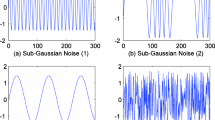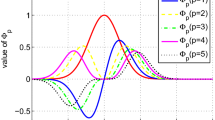Abstract
In this paper, a robust adaptive filter based on kernel risk-sensitive loss for bilinear forms is proposed. The proposed algorithm, called minimum kernel risk-sensitive loss bilinear form (MKRSL-BF), is derived by minimizing the cost function based on the minimum kernel risk-sensitive loss (MKRSL) criterion. The proposed algorithm can obtain the excellent performance when the system is corrupted by the impulsive noise. In addition, to further improve the performance of the MKRSL-BF algorithm, the novel algorithm based on the convex scheme is proposed, which can suppress the confliction between the fast convergence rate and the low steady-state error. Finally, simulations are carried out to verify the advantages of the proposed algorithms.





Similar content being viewed by others
Notes
For any matrices \( \left\{ {{\mathbf{A}},{\mathbf{B}},{\mathbf{C}}} \right\} \) of compatible dimensions, the Kronecker product has the properties
\( {\text{vec}}\left( {{\mathbf{ABC}}} \right) = \left( {{\mathbf{B}}^{T} \otimes {\mathbf{A}}} \right){\text{vec}}\left( {\mathbf{C}} \right) \),
\( {\text{tr}}\left( {{\mathbf{BA}}} \right) = {\text{tr}}\left( {{\mathbf{AB}}} \right) = \left( {{\text{vec(}}{\mathbf{A}}^{T} )} \right)^{T} {\text{vec(}}{\mathbf{B}} )n \).
References
J. Arenas-Garcia, A.R. Figueiras-Vidal, A.H. Sayed, Mean-square performance of a convex combination of two adaptive filters. IEEE Trans. Signal Process. 54(3), 1078–1090 (2006)
J. Arenas-Garcia, M. Martinez-Ramon, A. Navia-Vazquez, A.R. Figueiras-Vidal, Plant identification via adaptive combination of transversal filters. Signal Process. 86(9), 2430–2438 (2006)
J. Benesty, C. Paleologu, S. Ciochina, On the identification of bilinear forms with the Wiener filter. IEEE Signal Process. Lett. 24(5), 653–657 (2017)
H.K. Baik, V.J. Mathews, Adaptive lattice bilinear filters. IEEE Trans. Signal Process. 41(6), 2033–2046 (1993)
B. Chen, L. Xing, B. Xu, H. Zhao, N. Zheng, J.C. Príncipe, Kernel risk-sensitive loss: definition, properties and application to robust adaptive filtering. IEEE Trans. Signal Process. 65(11), 2888–2901 (2017)
B. Chen, L. Xing, H. Zhao, N. Zheng, J.C. Principe, Generalized correntropy for robust adaptive filtering. IEEE Trans. Signal Process. 64(13), 3376–3387 (2016)
B. Chen, L. Xing, J. Liang, N. Zheng, J.C. Principe, Steady-state mean-square error analysis for adaptive filtering under the maximum correntropy criterion. IEEE Signal Process. Lett. 21(7), 880–884 (2014)
B. Chen, J. Wang, H. Zhao, N. Zheng, J.C. Principe, Convergence of a fixed-point algorithm under maximum correntropy criterion. IEEE Signal Process. Lett. 22(10), 1723–1727 (2015)
P.S.R. Diniz, Adaptive Filtering: Algorithms and Practical Implementation, 4th edn. (Springer, New York, 2013)
U. Forssen, Adaptive bilinear digital filters. IEEE Trans. Circuits Systems-II: Analog Digit. Signal Process. 40, 729–735 (1993)
M. Ferrer, M.D. Diego, A. Gonzalez, G. Piñero, Convex combination of affine projection algorithms, in Proceedings of 17th European Signal Processing Conference, UK (2009), pp. 431–435
R. Hu, H.M. Hassan, Echo cancellation in high speed data transmission systems using adaptive layered bilinear filters. IEEE Trans. Commun. 42(234), 655–663 (1994)
S.M. Kuo, H.T. Wu, Nonlinear adaptive bilinear filters for active noise control systems. IEEE Trans. Circuits Syst. I Regul. Pap. 52(3), 617–624 (2005)
T. Koh, E.J. Powers, Second-order Volterra filtering and its application to nonlinear system identification. IEEE Trans. Acoust. Speech Signal Process. ASSP 33(6), 1445–1455 (1985)
L.S. Li, V.J. Mathews, Efficient block-adaptive parallel-cascade quadratic filters. IEEE Trans. Circuits Syst. II 46(4), 468–472 (1999)
L. Lu, H. Zhao, A novel convex combination of LMS adaptive filter for system identification, in 2014 12th International Conference on Signal Processing (ICSP), (China, Hangzhou, 2014), pp. 225–229
L. Lu, H. Zhao, B. Champagne, Distributed nonlinear system identification in α -stable noise. IEEE Signal Process. Lett. 25(7), 979–983 (2018)
L. Lu, H. Zhao, Adaptive combination of affine projection sign subband adaptive filters for modeling of acoustic paths in impulsive noise environments. Int. J. Speech Technol. 19(4), 907–917 (2017)
L. Lu, H. Zhao, B. Chen, Collaborative adaptive Volterra filters for nonlinear system identification in α-stable noise environments. J. Frankl. Inst. 353(17), 4500–4525 (2017)
W. Liu, P.P. Pokharel, J.C. Principe, Correntropy: properties and applications in non-gaussian signal processing. IEEE Trans. Signal Process. 55(11), 5286–5298 (2007)
G.-K. Ma, J. Lee, V. J. Mathews, A RLS bilinear filter for channel equalization, in Proceedings of IEEE ICASSP, (1994), pp. 257–260
S. Marsi, G.L. Sicuranza, On reduced-complexity approximation of quadratic filters, in Proceedings of 27th Asilomar Conference Signals, Systems, Computers, Pacific Grove, (CA, 1993), pp. 1026–1030
V.J. Mathews, G.L. Sicuranza, Polynomial Signal Processing (Wiley, Hoboken, 2000)
V.J. Mathews, Adaptive polynomial filters. IEEE Signal Process. Mag. 8(3), 10–26 (1991)
V. H. Nascimento, R. C. de Lamare, A low-complexity strategy for speeding up the convergence of convex combinations of adaptive filters, in IEEE International Conference on Acoustics, Speech and Signal Processing (ICASSP) (Kyoto, Japan, 2012), pp. 3553–3556
A. Navia-Vazquez, J. Arenas-Garcia, Combination of recursive least p-norm algorithms for robust adaptive filtering in alpha-stable noise. IEEE Trans. Signal Process. 60(3), 1478–1482 (2012)
T.M. Panicker, V. John, Mathews, Parallel-cascade realizations and approximations of truncated Volterra systems. IEEE Trans. Signal Process. 46(10), 2829–2832 (1998)
C. Paleologu, J. Benesty, S. Ciochina, An NLMS algorithm for the identification of bilinear forms, in Proceedings of EUSIPCO, (2017), pp. 2620–2624
C. Paleologu, S. Ciochina, J. Benesty, Analysis of an LMS algorithm for bilinear forms, in Digital Signal Processing (DSP), 2017 22nd International Conference on. IEEE, (2017), pp. 1–5
M.T.M. Silva, V.H. Nascimento, Improving the tracking capability of adaptive filters via convex combination. IEEE Trans. Signal Process. 56(7), 3137–3149 (2008)
A. Singh, J. C. Principe, Using correntropy as a cost function in linear adaptive filters, in Proceedings of IEEE 2009 International Joint Conference Neural Network, (2009), pp. 2950–2955
L. Shi, Y. Lin, Convex combination of adaptive filters under the maximum correntropy criterion in impulsive interference. IEEE Signal Process. Lett. 21(11), 1385–1388 (2014)
G. Sicuranza, Quadratic filters for signal processing. Proc. IEEE 80(8), 1263–1285 (1992)
M. Schetzen, Nonlinear system modeling based on the Wiener theory. Proc. IEEE 69(12), 1557–1573 (1981)
M. Schetzen, Volterra and Wiener Theory of the Nonlinear Systems (Wiley, New York, 1980)
L. Tan, J. Jiang, Nonlinear active noise control using diagonalchannel LMS and RLS bilinear filters, in Proceedings of IEEE MWSCAS, (2014), pp. 789–792
B. Weng, K.E. Barner, Nonlinear system identification in impulsive environments. IEEE Trans. Signal Process. 53(7), 2588–2594 (2005)
W. Wang, H. Zhao, B. Chen, Robust adaptive Volterra filter under maximum correntropy criteria in impulsive environments. Circuits Syst. Signal Process. 36(10), 4097–4117 (2017)
W. Wang, H. Zhao, Performance analysis of diffusion least mean fourth algorithm over network. Signal Process. 141, 32–47 (2017)
S. Zhao, B. Chen, J. C. Principe, Kernel adaptive filtering with maximum correntropy criterion, in Proceedings of IEEE International Joint Conference on Neural Network, (2011), pp. 2012–2017
Y. Yu, H. Zhao, Adaptive combination of proportionate NSAF with the tap-weights feedback for Acoustic echo cancellation. Wireless Pers. Commun. 92(2), 467–481 (2017)
Y. Yu, H. Zhao, Novel combination schemes of individual weighting factors sign subband adaptive filter algorithm. Int. J. Adapt. Contr. Signal Process. 31(8), 1193–1204 (2017)
H. Zhao, X. Zeng, Z. He, T. Li, W. Jin, Nonlinear adaptive filter-based simplified bilinear model for multichannel active control of nonlinear noise processes. Appl. Acoust. 74(12), 1414–1421 (2013)
Acknowledgements
This work was partially supported by the Doctoral Innovation Fund Program of Southwest Jiaotong University (Grant: D-CX201715) and the National Science Foundation of P.R. China (Grant: 61271340, 61571374 and 61433011).
Author information
Authors and Affiliations
Corresponding author
Rights and permissions
About this article
Cite this article
Wang, W., Zhao, H., Lu, L. et al. Robust Nonlinear Adaptive Filter Based on Kernel Risk-Sensitive Loss for Bilinear Forms. Circuits Syst Signal Process 38, 1876–1888 (2019). https://doi.org/10.1007/s00034-018-0928-z
Received:
Revised:
Accepted:
Published:
Issue Date:
DOI: https://doi.org/10.1007/s00034-018-0928-z




